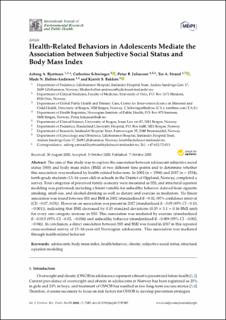| dc.contributor.author | Bjertnæs, Asborg Sine Aanstad | |
| dc.contributor.author | Schwinger, Catherine | |
| dc.contributor.author | Juliusson, Petur Benedikt | |
| dc.contributor.author | Strand, Tor A | |
| dc.contributor.author | Holten-Andersen, Mads Nikolaj | |
| dc.contributor.author | Bakken, Kjersti Sletten | |
| dc.date.accessioned | 2023-04-12T12:40:18Z | |
| dc.date.available | 2023-04-12T12:40:18Z | |
| dc.date.created | 2020-10-15T09:03:33Z | |
| dc.date.issued | 2020 | |
| dc.identifier.citation | International Journal of Environmental Research and Public Health (IJERPH). 2020, 17:7307 (19), 1-16. | en_US |
| dc.identifier.issn | 1661-7827 | |
| dc.identifier.uri | https://hdl.handle.net/11250/3062692 | |
| dc.description.abstract | The aim of this study was to explore the association between adolescent subjective social status (SSS) and body mass index (BMI) at two different time points and to determine whether this association was mediated by health-related behaviors. In 2002 (n = 1596) and 2017 (n = 1534), tenth-grade students (15-16 years old) in schools in the District of Oppland, Norway, completed a survey. Four categories of perceived family economy were measured as SSS, and structural equation modeling was performed, including a latent variable for unhealthy behavior derived from cigarette smoking, snuff-use, and alcohol-drinking as well as dietary and exercise as mediators. No linear association was found between SSS and BMI in 2002 (standardized ß -0.02, (95% confidence interval (CI) -0.07, 0.03)). However, an association was present in 2017 (standardized ß -0.05 (95% CI -0.10, -0.001)), indicating that BMI decreased by 0.05 standard deviations (0.05 × 3.1 = 0.16 BMI unit) for every one-category increase in SSS. This association was mediated by exercise (standardized ß -0.013 (95% CI -0.02, -0.004) and unhealthy behavior (standardized ß -0.009 (95% CI -0.002, -0.04)). In conclusion, a direct association between SSS and BMI was found in 2017 in this repeated cross-sectional survey of 15-16-year-old Norwegian adolescents. This association was mediated through health-related behavior. Keywords: adolescents; body mass index; health behavior; obesity; structural equation modeling; subjective social status. | en_US |
| dc.description.sponsorship | This research was funded by grants from the Innlandet Hospital Trust. | en_US |
| dc.language.iso | eng | en_US |
| dc.publisher | MDPI | en_US |
| dc.relation.uri | https://www.ncbi.nlm.nih.gov/pmc/articles/PMC7579492/pdf/ijerph-17-07307.pdf | |
| dc.rights | Navngivelse 4.0 Internasjonal | * |
| dc.rights.uri | http://creativecommons.org/licenses/by/4.0/deed.no | * |
| dc.subject | adolescents; | en_US |
| dc.subject | body mass index; | en_US |
| dc.subject | health behavior; | en_US |
| dc.subject | obesity; | en_US |
| dc.subject | structural equation modeling; | en_US |
| dc.subject | subjective social status; | en_US |
| dc.title | Health-related behaviors in adolescents mediate the association between subjective social status and body mass index | en_US |
| dc.type | Peer reviewed | en_US |
| dc.type | Journal article | en_US |
| dc.description.version | publishedVersion | en_US |
| dc.rights.holder | © 2020 by the authors. Licensee MDPI, Basel, Switzerland. This article is an open access article distributed under the terms and conditions of the Creative Commons Attribution (CC BY) license (http://creativecommons.org/licenses/by/4.0/). | en_US |
| dc.source.pagenumber | 1-16 | en_US |
| dc.source.volume | 17:7307 | en_US |
| dc.source.journal | International Journal of Environmental Research and Public Health (IJERPH) | en_US |
| dc.source.issue | 19 | en_US |
| dc.identifier.doi | 10.3390/ijerph17197307 | |
| dc.identifier.cristin | 1839724 | |
| cristin.ispublished | true | |
| cristin.fulltext | original | |
| cristin.qualitycode | 1 | |

